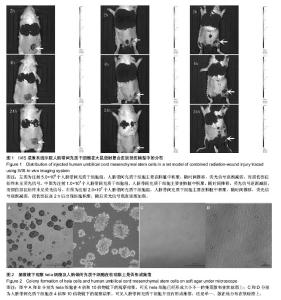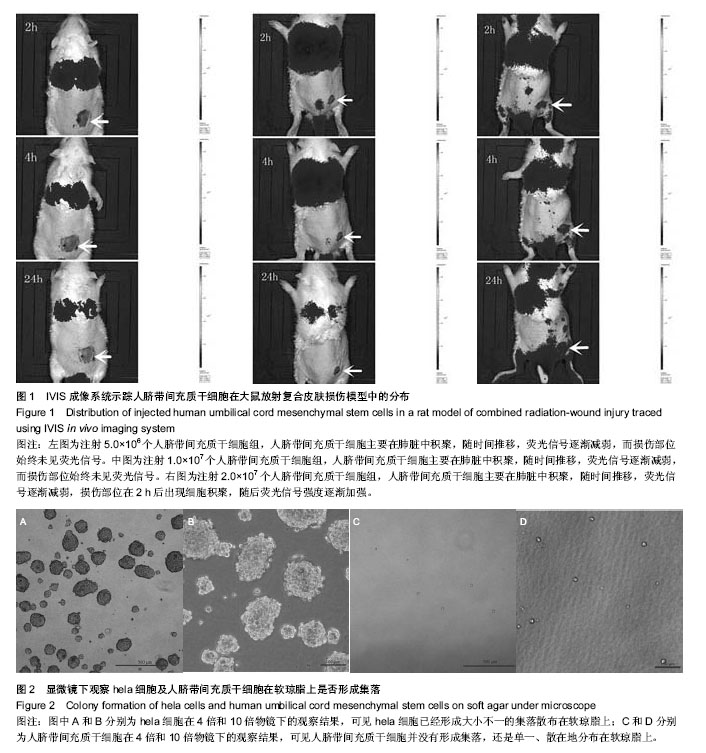| [1] Grammaticos P, Giannoula E, Fountos GP.Acute radiation syndrome and chronic radiation syndrome.Hell J Nucl Med. 2013;16(1):56-59.
[2] 刘建功,郭万龙,张淑贤,等.间充质干细胞在急性辐射损伤治疗中的作用综述[J].辐射研究与辐射工艺学报,2010,28(3):134- 137.
[3] Dörr H, Meineke V.Acute radiation syndrome caused by accidental radiation exposure - therapeutic principles.BMC Med. 2011;9:126.
[4] Dainiak N.Rationale and recommendations for treatment of radiation injury with cytokines.Health Phys. 2010;98(6): 838-842.
[5] López M, Martín M.Medical management of the acute radiation syndrome.Rep Pract Oncol Radiother. 2011; 16(4): 138-146.
[6] Akita S.Treatment of Radiation Injury.Adv Wound Care (New Rochelle). 2014;3(1):1-11.
[7] Glover D, Harmer V.Radiotherapy-induced skin reactions: assessment and management.Br J Nurs. 2014;23(4):S28, S30-35.
[8] López M, Martín M.Medical management of the acute radiation syndrome.Rep Pract Oncol Radiother. 2011;16(4): 138-146.
[9] da Silva Meirelles L, Chagastelles PC, Nardi NB. Mesenchymal stem cells reside in virtually all post-natal organs and tissues.J Cell Sci. 2006;119(Pt 11):2204-2213.
[10] Baksh D, Yao R, Tuan RS.Comparison of proliferative and multilineage differentiation potential of human mesenchymal stem cells derived from umbilical cord and bone marrow.Stem Cells. 2007;25(6):1384-1392.
[11] 李丽春,何治,李剑平.胎盘间充质干细胞的体外诱导分化[J].中国组织工程研究,2013,17(6):1116-1121.
[12] Stimpfel M, Cerkovnik P, Novakovic S, et al.Putative mesenchymal stem cells isolated from adult human ovaries.J Assist Reprod Genet. 2014. [Epub ahead of print]
[13] Dominici M, Le Blanc K, Mueller I,et al. Minimal criteria for defining multipotent mesenchymal stromal cells. The International Society for Cellular Therapy position statement. Cytotherapy. 2006;8(4):315-317.
[14] 王芳,汤永红.间充质干细胞免疫原性和免疫调节作用的研究进展[J].中南医学科学杂志, 2014,42(1): 97-100.
[15] Lee M, Jeong SY, Ha J,et al. Low immunogenicity of allogeneic human umbilical cord blood-derived mesenchymal stem cells in vitro and in vivo.Biochem Biophys Res Commun. 2014;446(4):983-989.
[16] Newman RE, Yoo D, LeRoux MA,et al.Treatment of inflammatory diseases with mesenchymal stem cells.Inflamm Allergy Drug Targets. 2009;8(2):110-123.
[17] Linard C, Busson E, Holler V,et al.Repeated autologous bone marrow-derived mesenchymal stem cell injections improve radiation-induced proctitis in pigs.Stem Cells Transl Med. 2013; 2(11):916-927.
[18] Wang R, Yuan W, Zhao Q,et al.An experimental study of preventing and treating acute radioactive enteritis with human umbilical cord mesenchymal stem cells.Asian Pac J Trop Med. 2013;6(12):968-971.
[19] 朱红燕,张宏,傅晋翔,等.骨髓间充质干细胞与急性皮肤放射损伤的修复[J].中国组织工程研究与临床康复,2009,13(32):6303- 6308.
[20] Kotenko KB, Moroz BB, Nadezhina NM,et al.Mesenchymal stem cells transplantation in the treatment of radiation skin lesions.Patol Fiziol Eksp Ter. 2011;(1):20-25.
[21] Yang D, Sun S, Wang Z,et al.Stromal cell-derived factor-1 receptor CXCR4-overexpressing bone marrow mesenchymal stem cells accelerate wound healing by migrating into skin injury areas.Cell Reprogram. 2013;15(3):206-215.
[22] Fakhari S, Kalantar E, Nikzaban M,et al. Effect of Helicobacter pylori infection on stromal-derived factor-1/CXCR4 axis in bone marrow-derived mesenchymal stem cells.Adv Biomed Res. 2014;3:19.
[23] 张大庆.单核细胞趋化蛋白-1在骨髓间充质干细胞向胶质瘤细胞趋化中的作用研究[D]. 大连:大连医科大学,2012.
[24] 李兴泽,孟庆海,金澎,等.趋化因子CXCL-8趋化骨髓间充质干细胞迁移的体外效应[J]. 中国组织工程研究与临床康复, 2009, 13(10):1908-1912.
[25] 王楠,张利,李清刚,等.骨髓间充质干细胞治疗急性腹膜纤维化作用方式的探讨[J].解放军医学杂志,2011,36(12):1263-1268.
[26] 房林.骨髓间充质干细胞移植促进皮肤创伤愈合的实验研究[D].北京:北京协和医学院,2010.
[27] Maxson S, Lopez EA, Yoo D,et al.Concise review: role of mesenchymal stem cells in wound repair.Stem Cells Transl Med. 2012;1(2):142-149.
[28] Singer NG, Caplan AI.Mesenchymal stem cells: mechanisms of inflammation.Annu Rev Pathol. 2011;6:457-478.
[29] Krasnodembskaya A, Song Y, Fang X,et al. Antibacterial effect of human mesenchymal stem cells is mediated in part from secretion of the antimicrobial peptide LL-37.Stem Cells. 2010;28(12):2229-2238.
[30] Mei SH, Haitsma JJ, Dos Santos CC,et al.Mesenchymal stem cells reduce inflammation while enhancing bacterial clearance and improving survival in sepsis.Am J Respir Crit Care Med. 2010;182(8):1047-1057.
[31] Hocking AM, Gibran NS.Mesenchymal stem cells: paracrine signaling and differentiation during cutaneous wound repair. Exp Cell Res. 2010;316(14):2213-2219.
[32] Colwell AS, Beanes SR, Soo C,et al. Increased angiogenesis and expression of vascular endothelial growth factor during scarless repair.Plast Reconstr Surg. 2005;115(1):204-212.
[33] Smith AN, Willis E, Chan VT,et al. Mesenchymal stem cells induce dermal fibroblast responses to injury.Exp Cell Res. 2010;316(1):48-54.
[34] Ra JC, Shin IS, Kim SH,et al.Safety of intravenous infusion of human adipose tissue-derived mesenchymal stem cells in animals and humans.Stem Cells Dev. 2011;20(8):1297-1308.
[35] 秦秀军,张伟,李建国,等.人脂肪间充质干细胞的致瘤性研究[J].天津医药,2013,41(2):152-153. |

